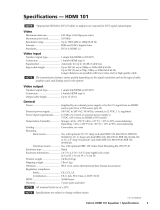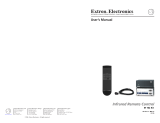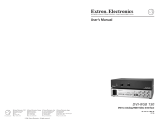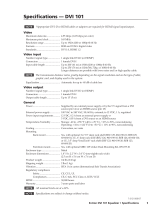Page is loading ...

User’s Manual
Dual Link DVI Transmitter and Receiver
DVI DL 201 Tx/Rx
68-1531-01
Rev. B
12 08

Precautions
This symbol is intended to alert the user of important
operating and maintenance (servicing) instructions in
the literature provided with the equipment.
This symbol is intended to alert the user of the
presence of uninsulated dangerous voltage within
the product’s enclosure that may present a risk of
electric shock.
Caution
Read Instructions • Read and understand all safety and operating
instructions before using the equipment.
Retain Instructions • The safety instructions should be kept for future
reference.
Follow Warnings • Follow all warnings and instructions marked on the
equipment or in the user information.
Avoid Attachments • Do not use tools or attachments that are not
recommended by the equipment manufacturer because they may be
hazardous.
Warning
Power sources • This equipment should be operated only from the power source
indicated on the product. This equipment is intended to be used with a main power
system with a grounded (neutral) conductor. The third (grounding) pin is a safety
feature, do not attempt to bypass or disable it.
Power disconnection • To remove power from the equipment safely, remove all power
cords from the rear of the equipment, or the desktop power module (if detachable),
or from the power source receptacle (wall plug).
Power cord protection • Power cords should be routed so that they are not likely to be
stepped on or pinched by items placed upon or against them.
Servicing • Refer all servicing to qualified service personnel. There are no user-
serviceable parts inside. To prevent the risk of shock, do not attempt to service
this equipment yourself because opening or removing covers may expose you to
dangerous voltage or other hazards.
Slots and openings • If the equipment has slots or holes in the enclosure, these are
provided to prevent overheating of sensitive components inside. These openings
must never be blocked by other objects.
Lithium battery • There is a danger of explosion if battery is incorrectly
replaced. Replace it only with the same or equivalent type recommended by
the manufacturer. Dispose of used batteries according to the manufacturer’s
instructions.
Ce symbole sert à avertir l’utilisateur que la
documentation fournie avec le matériel contient des
instructions importantes concernant l’exploitation et
la maintenance (réparation).
Ce symbole sert à avertir l’utilisateur de la présence
dans le boîtier de l’appareil de tensions dangereuses
non isolées posant des risques d’électrocution.
Attention
Lire les instructions• Prendre connaissance de toutes les consignes de
sécurité et d’exploitation avant d’utiliser le matériel.
Conserver les instructions• Ranger les consignes de sécurité afin de pouvoir
les consulter à l’avenir.
Respecter les avertissements • Observer tous les avertissements et consignes
marqués sur le matériel ou présentés dans la documentation utilisateur.
Eviter les pièces de xation • Ne pas utiliser de pièces de fixation ni d’outils
non recommandés par le fabricant du matériel car cela risquerait de poser
certains dangers.
Avertissement
Alimentations• Ne faire fonctionner ce matériel qu’avec la source d’alimentation
indiquée sur l’appareil. Ce matériel doit être utilisé avec une alimentation principale
comportant un fil de terre (neutre). Le troisième contact (de mise à la terre) constitue
un dispositif de sécurité : n’essayez pas de la contourner ni de la désactiver.
Déconnexion de l’alimentation• Pour mettre le matériel hors tension sans danger,
déconnectez tous les cordons d’alimentation de l’arrière de l’appareil ou du module
d’alimentation de bureau (s’il est amovible) ou encore de la prise secteur.
Protection du cordon d’alimentation • Acheminer les cordons d’alimentation de
manière à ce que personne ne risque de marcher dessus et à ce qu’ils ne soient pas
écrasés ou pincés par des objets.
Réparation-maintenance • Faire exécuter toutes les interventions de réparation-
maintenance par un technicien qualifié. Aucun des éléments internes ne peut être
réparé par l’utilisateur. Afin d’éviter tout danger d’électrocution, l’utilisateur ne doit
pas essayer de procéder lui-même à ces opérations car l’ouverture ou le retrait des
couvercles risquent de l’exposer à de hautes tensions et autres dangers.
Fentes et orices • Si le boîtier de l’appareil comporte des fentes ou des orifices, ceux-ci
servent à empêcher les composants internes sensibles de surchauffer. Ces ouvertures
ne doivent jamais être bloquées par des objets.
Lithium Batterie • Il a danger d’explosion s’ll y a remplacment incorrect de la batterie.
Remplacer uniquement avec une batterie du meme type ou d’un ype equivalent
recommande par le constructeur. Mettre au reut les batteries usagees conformement
aux instructions du fabricant.
Safety Instructions • English
Consignes de Sécurité • Français
Sicherheitsanleitungen • Deutsch
Dieses Symbol soll dem Benutzer in der im
Lieferumfang enthaltenen Dokumentation
besonders wichtige Hinweise zur Bedienung und
Wartung (Instandhaltung) geben.
Dieses Symbol soll den Benutzer darauf aufmerksam
machen, daß im Inneren des Gehäuses dieses
Produktes gefährliche Spannungen, die nicht isoliert
sind und die einen elektrischen Schock verursachen
können, herrschen.
Achtung
Lesen der Anleitungen • Bevor Sie das Gerät zum ersten Mal verwenden,
sollten Sie alle Sicherheits-und Bedienungsanleitungen genau durchlesen
und verstehen.
Aufbewahren der Anleitungen • Die Hinweise zur elektrischen Sicherheit
des Produktes sollten Sie aufbewahren, damit Sie im Bedarfsfall darauf
zurückgreifen können.
Befolgen der Warnhinweise • Befolgen Sie alle Warnhinweise und
Anleitungen auf dem Gerät oder in der Benutzerdokumentation.
Keine Zusatzgeräte • Verwenden Sie keine Werkzeuge oder Zusatzgeräte,
die nicht ausdrücklich vom Hersteller empfohlen wurden, da diese eine
Gefahrenquelle darstellen können.
Vorsicht
Stromquellen • Dieses Gerät sollte nur über die auf dem Produkt angegebene
Stromquelle betrieben werden. Dieses Gerät wurde für eine Verwendung mit einer
Hauptstromleitung mit einem geerdeten (neutralen) Leiter konzipiert. Der dritte
Kontakt ist für einen Erdanschluß, und stellt eine Sicherheitsfunktion dar. Diese
sollte nicht umgangen oder außer Betrieb gesetzt werden.
Stromunterbrechung • Um das Gerät auf sichere Weise vom Netz zu trennen, sollten
Sie alle Netzkabel aus der Rückseite des Gerätes, aus der externen Stomversorgung
(falls dies möglich ist) oder aus der Wandsteckdose ziehen.
Schutz des Netzkabels • Netzkabel sollten stets so verlegt werden, daß sie nicht im
Weg liegen und niemand darauf treten kann oder Objekte darauf- oder unmittelbar
dagegengestellt werden können.
Wartung • Alle Wartungsmaßnahmen sollten nur von qualiziertem Servicepersonal
durchgeführt werden. Die internen Komponenten des Gerätes sind wartungsfrei.
Zur Vermeidung eines elektrischen Schocks versuchen Sie in keinem Fall, dieses
Gerät selbst öffnen, da beim Entfernen der Abdeckungen die Gefahr eines
elektrischen Schlags und/oder andere Gefahren bestehen.
Schlitze und Öffnungen • Wenn das Gerät Schlitze oder Löcher im Gehäuse aufweist,
dienen diese zur Vermeidung einer Überhitzung der empndlichen Teile im
Inneren. Diese Öffnungen dürfen niemals von anderen Objekten blockiert werden.
Litium-Batterie • Explosionsgefahr, falls die Batterie nicht richtig ersetzt
wird. Ersetzen Sie verbrauchte Batterien nur durch den gleichen oder einen
vergleichbaren Batterietyp, der auch vom Hersteller empfohlen wird. Entsorgen Sie
verbrauchte Batterien bitte gemäß den Herstelleranweisungen.
Este símbolo se utiliza para advertir al usuario
sobre instrucciones importantes de operación y
mantenimiento (o cambio de partes) que se desean
destacar en el contenido de la documentación
suministrada con los equipos.
Este símbolo se utiliza para advertir al usuario sobre
la presencia de elementos con voltaje peligroso sin
protección aislante, que puedan encontrarse dentro
de la caja o alojamiento del producto, y que puedan
representar riesgo de electrocución.
Precaucion
Leer las instrucciones • Leer y analizar todas las instrucciones de operación y
seguridad, antes de usar el equipo.
Conservar las instrucciones • Conservar las instrucciones de seguridad para
futura consulta.
Obedecer las advertencias • Todas las advertencias e instrucciones marcadas
en el equipo o en la documentación del usuario, deben ser obedecidas.
Evitar el uso de accesorios • No usar herramientas o accesorios que no
sean especificamente recomendados por el fabricante, ya que podrian
implicar riesgos.
Advertencia
Alimentación eléctrica • Este equipo debe conectarse únicamente a la fuente/tipo
de alimentación eléctrica indicada en el mismo. La alimentación eléctrica de este
equipo debe provenir de un sistema de distribución general con conductor neutro
a tierra. La tercera pata (puesta a tierra) es una medida de seguridad, no puentearia
ni eliminaria.
Desconexión de alimentación eléctrica • Para desconectar con seguridad la acometida
de alimentación eléctrica al equipo, desenchufar todos los cables de alimentación
en el panel trasero del equipo, o desenchufar el módulo de alimentación (si fuera
independiente), o desenchufar el cable del receptáculo de la pared.
Protección del cables de alimentación • Los cables de alimentación eléctrica se deben
instalar en lugares donde no sean pisados ni apretados por objetos que se puedan
apoyar sobre ellos.
Reparaciones/mantenimiento • Solicitar siempre los servicios técnicos de personal
calificado. En el interior no hay partes a las que el usuario deba acceder. Para evitar
riesgo de electrocución, no intentar personalmente la reparación/mantenimiento
de este equipo, ya que al abrir o extraer las tapas puede quedar expuesto a voltajes
peligrosos u otros riesgos.
Ranuras y aberturas • Si el equipo posee ranuras o orificios en su caja/alojamiento,
es para evitar el sobrecalientamiento de componentes internos sensibles. Estas
aberturas nunca se deben obstruir con otros objetos.
Batería de litio • Existe riesgo de explosión si esta batería se coloca en la posición
incorrecta. Cambiar esta batería únicamente con el mismo tipo (o su equivalente)
recomendado por el fabricante. Desachar las baterías usadas siguiendo las
instrucciones del fabricante.
Instrucciones de seguridad • Español

安全须知 • 中文
这个符号提示用户该设备用户手册中
有重要的操作和维护说明。
这个符号警告用户该设备机壳内有暴
露的危险电压,有触电危险。
注意
阅读说明书 • 用户使用该设备前必须阅读并理
解所有安全和使用说明。
保存说明书 • 用户应保存安全说明书以备将来使
用。
遵守警告 • 用户应遵守产品和用户指南上的所有安
全和操作说明。
避免追加 • 不要使用该产品厂商没有推荐的工具或
追加设备,以避免危险。
警告
电源 • 该设备只能使用产品上标明的电源。 设备
必须使用有地线的供电系统供电。 第三条线
(地线)是安全设施,不能不用或跳过。
拔掉电源 • 为安全地从设备拔掉电源,请拔掉所有设备后
或桌面电源的电源线,或任何接到市电系统的电源线。
电源线保护 • 妥善布线, 避免被踩踏,或重物挤压。
维护 • 所有维修必须由认证的维修人员进行。 设备内部
没有用户可以更换的零件。为避免出现触电危险不要自
己试图打开设备盖子维修该设备。
通风孔 • 有些设备机壳上有通风槽或孔,它们是用来防止
机内敏感元件过热。 不要用任何东西挡住通风孔。
锂电池 • 不正确的更换电池会有爆炸的危险。 必须使用
与厂家推荐的相同或相近型号的电池。 按照生产厂的
建议处理废弃电池。
声明
所使用电源为 A 级产品,在生活环境中,该产品可能会造成无线电干扰。在这种情况下,可能需要用
户对其干扰采取切实可行的措施。
FCC Class A Notice
This equipment has been tested and found to comply with the limits for a Class A digital device,
pursuant to part 15 of the FCC Rules. Operation is subject to the following two conditions: (1) this
device may not cause harmful interference, and (2) this device must accept any interference received,
including interference that may cause undesired operation. The Class A limits are designed to
provide reasonable protection against harmful interference when the equipment is operated in
a commercial environment. This equipment generates, uses, and can radiate radio frequency
energy and, if not installed and used in accordance with the instruction manual, may cause harmful
interference to radio communications. Operation of this equipment in a residential area is likely to
cause harmful interference, in which case the user will be required to correct the interference at his
own expense.
N
This unit was tested with shielded cables on the peripheral devices. Shielded cables must be used
with the unit to ensure compliance with FCC emissions limits.


DVI DL 201 Tx/Rx • Quick Start Guide
QS-1
Quick Start Guide — DVI DL 201 Tx/Rx
The DVI DL 201 Tx/Rx extends DVI-D signals up to 100' (30 m) at
resolutions up to 2560x1600 @ 60 Hz, using twisted pair (TP) cable.
Install, connect, and operate the DVI DL 201 Tx/Rx as follows:
Step 1
Turn off all equipment or disconnect it from power sources. Mount
the transmitter and receiver as desired (see page 2-2).
Step 2
Determine how the source device will obtain the EDID information
and perform one of the following procedures:
To capture the EDID of a desired display and store it in
the EDID Minder for future use:
a. Connect the display to the local monitor output of
the transmitter.
b. Power on the transmitter and the local monitor.
c. Congure the DDC switches as shown in the gure
at right and described on page 3-2.
d. Press and release the EDID "Store" button (see
the gure at right). The rear panel LED turns
amber while the EDID information is read and
stored from the local monitor. Afterwards, the
LED turns green.
e. Power off and disconnect the display from the
transmitter.
f. Connect the transmitter to the receiver.
g. Connect a source device to the transmitter.
h. Connect a display device to the receiver and, if required, a local
monitor to the transmitter.
i. Power on the display device(s), the transmitter, and the receiver.
j. Power on the source device.
To use the default EDID (2560x1600 @ 60 Hz):
a. Congure the DDC switches as shown in the gure
at right and described on page 3-3.
b. Connect a source device to the transmitter.
c. Connect a display device to the receiver and, if
required, a local monitor to the transmitter.
d. Connect the transmitter and receiver.
e. Power on the transmitter, receiver, and display devices.
f. Power on the source device.
ON
1 2 3
ON
OFF
DEFAULT EDID
EDID MINDER
REMOTE DDC
STORE
EDID
ON
1 2 3
ON
OFF
DEFAULT EDID
EDID MINDER
REMOTE DDC

DVI DL 201 Tx/Rx • Quick Start Guide
Quick Start Guide — DVI DL 201 Tx/Rx, cont’d
QS-2
To use DDC pass-through routed to the local monitor:
a. Congure the DDC switches as shown in the gure
at right and described on page 3-4.
b. Connect a source device to the transmitter.
c. Connect a display device to the receiver and, if
required, a local monitor to the transmitter.
d. Connect the transmitter and receiver.
e. Power on the transmitter, receiver, and local
monitor.
f. Power on the source device.
g. Power on the display device.
To use DDC pass-through routed to the remote display:
Congure the DDC switches as shown in the gure a.
at right and described on page 3-5.
Connect a source device to the transmitter.b.
Connect a display device to the receiver and, if c.
required, a local monitor to the transmitter.
Connect the transmitter and receiver.d.
Power on the transmitter, receiver, and display e.
devices.
Power on the source device.f.
N
If there are any problems, consult the troubleshooting section
(page 3-6).
12V
0.4A MAX
POWER
DVI-D INPUT
RS-232
PASS-THRU
DO NOT
CONNECT
OUTPUTS
TO LAN
DDC ROUTE
REMOTE
SPARE
LOCAL
LOCAL OUTPUT OUTPUT
OUTPUT
1
2
3
PC with Dual Link
DVI Output
Local Monitor
DVI Dual Link
Extron
DVI DL 201 Tx
DVI Dual Link
Transmitter
Extron
DVI DL 201 Rx
DVI Dual Link
Receiver
DVI DL 201 Rx
RS-232
PASS THRU
Tx Rx
DVI-D OUTPUT
High Resolution
Projector with
Dual Link Input
Twisted Pair
Cables (3) 100’
DVI DL 201 Rx SERIES
DVI-D OUTPUT
Tx Rx
CONTROL
PASS THRU
ON
1 2 3
ON
OFF
DEFAULT EDID
EDID MINDER
REMOTE DDC
ON
1 2 3
ON
OFF
DEFAULT EDID
EDID MINDER
REMOTE DDC

i
DVI DL 201 Tx/Rx • Table of Contents
i
Chapter One • Introduction .................................................... 1-1
About this Manual .................................................................... 1-2
About the DVI DL 201 Tx/Rx .................................................. 1-2
DVI DL 201 Tx/Rx Features ..................................................... 1-2
Chapter Two • Installation ...................................................... 2-1
Mounting the DVI DL 201 Tx/Rx ........................................... 2-2
Tabletop placement ............................................................... 2-2
Rack mounting ....................................................................... 2-2
UL guidelines for rack mounting ...........................................2-2
Rack mounting procedures ....................................................2-3
Under-desk mounting ............................................................ 2-4
Through-desk mounting ........................................................ 2-5
Pole mounting ........................................................................ 2-6
Panel Features............................................................................. 2-8
DVI DL 201 Tx front panel features ...................................... 2-8
DVI DL 201 Tx rear panel features ........................................ 2-9
DVI DL 201 Rx front panel features .................................... 2-10
DVI DL 201 Rx rear panel features ...................................... 2-11
Cable Connections and Switches ....................................... 2-12
DVI-D input ........................................................................... 2-12
DVI-D output ........................................................................ 2-12
Twisted pair output/input ................................................... 2-14
Terminating shielded cable ..................................................2-14
Connections ..........................................................................2-15
Single Link/Dual Link DVI ....................................................2-16
DDC switches ........................................................................ 2-17
Control pass-through ........................................................... 2-18
RS-232 signals .......................................................................2-19
IR signals ...............................................................................2-19
Power input .......................................................................... 2-20
Table of Contents

ii
DVI DL 201 Tx/Rx • Table of Contents
Table of Contents, cont’d
Chapter Three • Configuration and Operation ......... 3-1
Conguration .............................................................................. 3-2
Using the EDID Minder to read and store EDID from a
displa..................................................................................... 3-2
Using the EDID Minder with the default EDID .................... 3-3
Using pass-through mode with DDC routed to a local
monitor ................................................................................... 3-4
Using pass-through mode with DDC routed to the remote
displa..................................................................................... 3-5
Setup .............................................................................................. 3-6
Troubleshooting ......................................................................... 3-6
Appendix A • Reference Information ............................A-1
Specications ..............................................................................A-2
Included Parts .............................................................................A-5
Optional Accessories ................................................................A-5
68-1531-01
Rev. B
12 08
All trademarks mentioned in this manual are the properties of their respective owners.

DVI DL 201 Tx/Rx
1
Chapter One
Introduction
About this Manual
About the DVI DL 201 Tx/Rx
DVI DL 201 Tx/Rx Features

DVI DL 201 Tx/Rx • Introduction
Introduction
About this Manual
This manual contains information about the DVI DL 201 Tx/Rx
signal transmitter and receiver, with information on how to
mount, install, and operate these units.
In this manual, unless otherwise specied, the terms
"DVI DL 201" or "DVI DL 201 Tx/Rx" refer to both the
transmitter (DVI DL 201 Tx) and the receiver (DVI DL 201 Rx).
The term "transmitter" refers to the DVI DL 201 Tx, and
"receiver" refers to the DVI DL 201 Rx.
About the DVI DL 201 Tx/Rx
The DVI DL 201 Tx and DVI DL 201 Rx are dual link DVI
transmitter/receiver units. They can be purchased as a pair or
as individual units.
Each purchased pair and each individual unit is shipped with a
single external desktop 12 VDC power supply. A single power
supply, connected to the transmitter, is able to power both
devices.
Using three CAT 5/5e/6/7 twisted pair cables, DVI-D signals
can be extended up to 100' (30 m) at resolutions up to 2560 x
1600 @ 60 Hz. This is signicantly further than the 15' (5 m)
specied for standard dual link DVI cables.
N
The DVI DL 201 Tx/Rx works with unshielded twisted
pair (UTP) cable or shielded twisted pair (STP) cable.
However, STP cables are required to ensure FCC Class A
and CE compliance.
DVI DL 201 Tx/Rx Features
Transmits dual link DVI-D signals over three CAT 5/5e/6/7
cables — Standard twisted pair cables provide an economical,
easily installed cable solution.
Long distance transmission — Signals are transmitted up to
100' (30 m), which is signicantly further than the 15' (5 m)
specied for standard dual link DVI cables.
Local monitor output — The transmitter has a DVI-D output for
connection to a local monitor.
DDC routing to local or remote display — A two pole switch
allows the user to determine whether DDC signals are routed to
the local or the remote display device.
1-2

DVI DL 201 Tx/Rx • Introduction
1-3
EDID Minder — The EDID Minder maintains continuous EDID
(Extended Display Identication Data) communication with
the attached source. This ensures that the DVI source powers
up correctly and maintains a proper video output, even if the
display is off.
Control communications pass-through — The DVI DL 201
passes through RS-232 (two way) or IR (one way) control
signals, to a remote display.
Compact design — The transmitter is 1U high, a half rack wide
and 3" deep, for easy rack mounting near the source device.
The receiver is 1" high, a quarter rack wide and 3" deep,
allowing multiple mounting options near the display device.
Remote powering of receiver — A single power supply,
connected to the transmitter, is able to power both the
transmitter and receiver.
DVI DL 201 Rx
DVI-D OUTPUT
Tx Rx
CONTROL
PASS THRU
12V
0.4A MAX
POWER
DVI-D INPUT
RS-232
PASS-THRU
DO NOT
CONNECT
OUTPUTS
TO LAN
DDC ROUTE
REMOTE
SPARE
LOCAL
LOCAL OUTPUT OUTPUT
1
2
3
PC w/ Dual Link DVI
Output
Local
Monitor
Control
System
Dual Link
DVI Cable
RS-232
RS-232
Extron
DVI DL 201 Tx
Dual Link DVI
Transmitter
Extron
DVI DL 201 Rx
Dual Link DVI
Receiver
CAT 5/5e/6/7 Cables
up to 200 feet
2560 x 1600 Flat Panel
Display with Dual-Link
DVI Input
Typical Application for the DVI DL 201 Tx/Rx

DVI DL 201 Tx/Rx • Introduction
Introduction, cont’d
1-4

DVI DL 201 Tx/Rx
2
Chapter Two
Installation
Mounting the DVI DL 201 Tx/Rx
Panel Features
Cable Connections and Switches

DVI DL 201 Tx/Rx • Installation
Installation
Mounting the DVI DL 201 Tx/Rx
The transmitter is 1U high, a half rack wide and 3" deep, for
easy rack mounting near the source device.
The receiver is 1" high, a quarter rack wide and 3" deep,
allowing multiple mounting options near the display device.
Tabletop placement
Attach the four included rubber feet to the bottom of the unit
and place it in any convenient location.
Rack mounting
UL guidelines for rack mounting
The following Underwriters Laboratories (UL) guidelines are
relevant to the safe installation of the DVI DL 201 Tx/Rx in a
rack:
1. Elevated operating ambient temperature — If the unit
is installed in a closed or multi-unit rack assembly, the
operating ambient temperature of the rack environment
may be greater than room ambient temperature. Therefore,
install the equipment in an environment compatible with
the maximum ambient temperature (Tma: +122 °F, +50 °C)
specied by Extron.
2. Reduced air flow — Install the equipment in the rack
so that the equipment gets adequate air ow for safe
operation.
3. Mechanical loading — Mount the equipment in the rack
so that uneven mechanical loading does not create a
hazardous condition.
4. Circuit overloading — Connect the equipment to
the supply circuit and consider the effect that circuit
overloading might have on overcurrent protection and
supply wiring. Give appropriate consideration to the
equipment nameplate ratings when addressing this
concern.
5. Reliable earthing (grounding) — Maintain reliable
grounding of rack-mounted equipment. Pay particular
attention to supply connections other than direct
connections to the branch circuit (such as the use of power
strips).
2-2

DVI DL 201 Tx/Rx • Installation
Rack mounting procedures
The unit can be mounted in the front or rear of:
RSU 126 (6" deep 1U universal rack shelf kit: PN • 60-190-10)
RSB 126 (6" deep 1U basic rack shelf: PN • 60-604-10)
RSU 129 (9.5" deep 1U universal rack shelf kit: PN • 60-190-01)
RSB 129 (9.5" deep 1U basic rack shelf: PN • 60-604-01)
To mount the unit, follow these instructions:
1. Remove rubber feet if these have been installed on the
bottom of the unit.
2. Align the unit on the shelf and secure it to the shelf with
two 4-40 x 3/16" screws in diagonally opposite corners (see
the gure below, which shows installation using the
RSU 129 shelf).
3. Install false faceplate(s) or other unit(s) to the rack shelf.
4. Attach the shelf to the rack with the four provided
10-32 x 3/4" bolts
Use 2 mounting holes on
opposite corners.
(2) 4-40 x 3/16"
Screws
1U Universal Rack Shelf
Front false
faceplate
uses 2
screws.
HalfRackVersaToolsStandardShelf
1/2 Rack Width Front False
Faceplate
Installing the DVI DL 201 Tx on a rack shelf
2-3

DVI DL 201 Tx/Rx • Installation
Installation, cont’d
2-4
Under-desk mounting
The gure below shows how to mount the DVI DL 201 Tx under
a desk or podium, using the optional Extron MBU 123 under
desk mounting kit (PN 70-212-01). To mount the
DVI DL 201 Rx, the optional Extron MBU 125 under desk
mounting kit (PN 70-077-01, not shown) must be used. For
either unit, follow these instructions:
1. Remove rubber feet if these have been installed on the
bottom of the unit.
2. Secure the mounting brackets to the unit, using the four
4-40 screws provided (see the gure below).
Under-desk mounting the DVI DL 201 Tx
3. Hold the unit with the brackets attached against the
underside of the table or other furniture. Mark the location
of the screw holes of the bracket on the mounting surface.
4. Drill four pilot holes, each 3/32" (2 mm) in diameter by
1/4" (6.3 mm) deep in the mounting surface at the marked
screw locations.
5. Insert #8 wood screws into the four pilot holes. Tighten
each screw into the mounting surface until just less than
1/4" (6.3 mm) of the screw head protrudes.
6. Guide the mounting screws through the slots in the
brackets and place the unit tight against the surface.
7. Slide the unit slightly in or out so that it is held in place
by the screws; tighten all four screws to secure the unit in
place (see the gure above).

DVI DL 201 Tx/Rx • Installation
2-5
Through-desk mounting
The DVI DL 201 Tx should not be mounted through a desk.
To mount the DVI DL 201 Rx through a desk or podium, use
the optional Extron MBD 129 through-desk mounting kit
(PN 70-077-02), and follow these instructions:
1. Remove rubber feet if these have been installed on the
bottom of the unit.
2. Attach the brackets to the receiver, using the four 4-40
screws provided; leave the screws slightly loose.
Through-desk mounting the DVI DL 201 Rx
3. Hold the unit in position under the mounting surface.
Mark the location of the four screw holes and the
mounting hole to be cut in the table.
4. Cut away the table material. Test the t by inserting the
front of the device through the hole. If necessary, use a
rasp or coarse le to enlarge the hole.
5. Hold the receiver, with the brackets attached, in position
and mark the location of the holes in the brackets. Drill
four pilot holes, each 3/32" (2 mm) in diameter by 1/4"
deep (6.3 mm) deep.
6. Attach the brackets to the mounting surface, using the four
#8 wood screws provided with the kit.
7. Slide the device in or out until the front panel is ush with
the table surface. Tighten the screws installed in step 2.
8. If the screws are inaccessible to a screwdriver, mark the
location of the unit relative to the brackets, remove the unit
and brackets, tighten the screws holding the brackets and
replace the unit as described in step 6.

DVI DL 201 Tx/Rx • Installation
Installation, cont’d
2-6
Pole mounting
The instructions for mounting the receiver on the projector pole,
using the PMK 300 pole mounting kit (PN 70-374-01), are shown
below. For instructions on using any other Extron projector
mounting kit, consult the appropriate user guide.
1. If necessary, remove the rubber feet from the bottom of the
DVI DL 201 Rx.
2. Mount the receiver to any of the bracket's three mounting
plates. The unit should be vertically mounted with the
front panel (DVI output) facing towards the projector and
the rear panel (RJ-45 slots) facing towards the ceiling.
Extron
PMK 300
Multi Product Projector
Mount Kit
U-Bolt
Rubber Pad
Backing
Brace
Clamping
Plate
Projector mounting the DVI DL 201 Rx

DVI DL 201 Tx/Rx • Installation
2-7
N
On the side mounting plates, the device is typically
mounted on the outside of the bracket. On the front
mounting plate, the device is mounted on the inside of
the bracket.
a. Use the two 4-40 x 3/16" screws (provided) to secure
the receiver to the bracket
b. If required, secure the power supply using the plastic
ties provided with the kit.
N
The projector pole can be clamped to the back surface of
the clamping plate on the PMK 300, as shown in the
figure on the previous page.
Alternatively, the PMK 300 has a hole in the bottom
plate that allows the projector pole to be inserted through
the center of the plate. In this configuration, slide the
PMK 300 up from the bottom of the pole before the
projector is installed.
3. Attach the rubber pad to the surface of the clamping plate
that will be in contact with the pole.
4. Place the U-bolt around the projector pole and insert the
two ends through the slotted holes in the clamping plate
and then through the round holes in the backing brace.
N
The provided U-bolt fits a pole with an external diameter
of 1.5" to 2.0". For larger or smaller diameter poles,
obtain a U-bolt from a local hardware store. The slotted
holes in the clamping plate can accommodate U-bolts
that are 1.0" to 2.5" in width.
5. Secure the bracket to the projector pole with the U-bolt and
the provided hex nuts and washers. Use an appropriately-
sized socket wrench to tighten the hex nuts.

DVI DL 201 Tx/Rx • Installation
Installation, cont’d
2-8
Panel Features
DVI DL 201 Tx front panel features
The illustration below shows the front panel features of the
DVI DL 201 Tx.
DVI DL 201 Tx
DVI DUAL LINK TRANSMITTER
1
DVI DL 201 Tx front panel features
a
LED — An amber light indicates that the DVI DL 201 Tx is
receiving power from a power supply or remotely, through
the receiver. A green light indicates that the transmitter is also
receiving a video signal.
/





